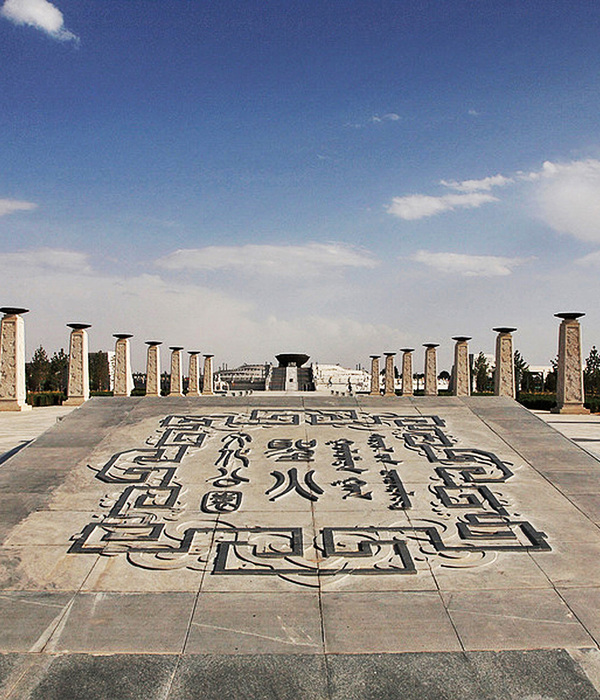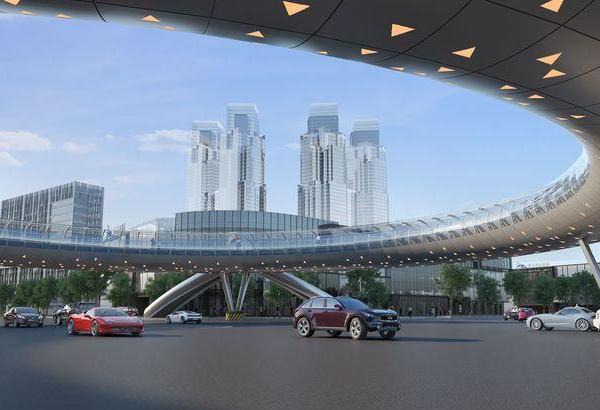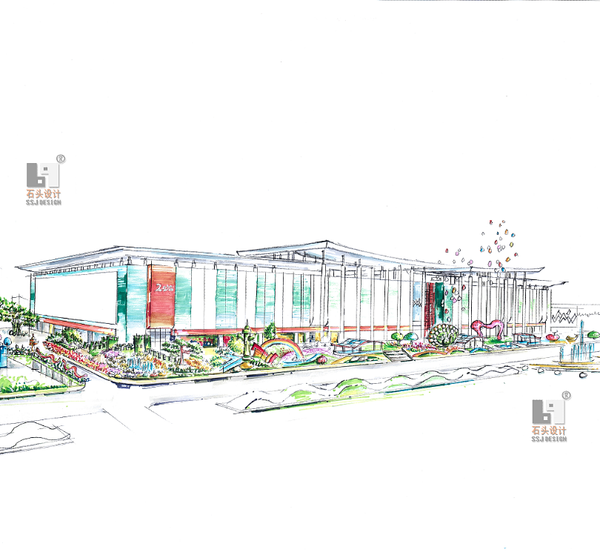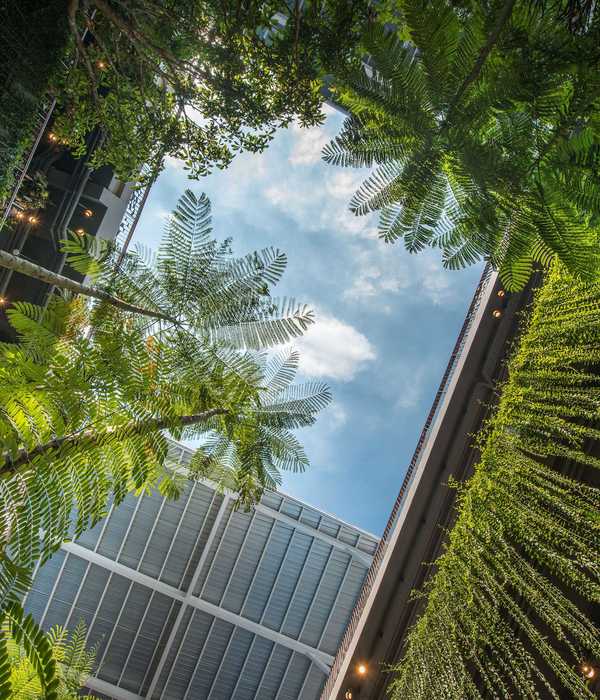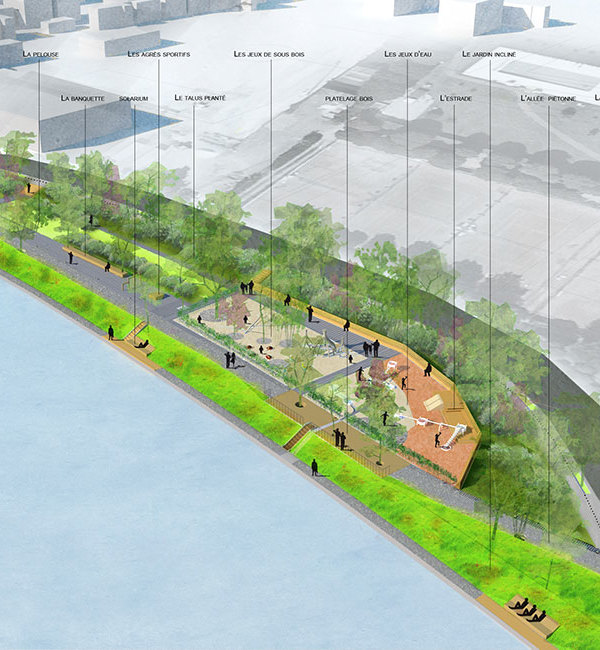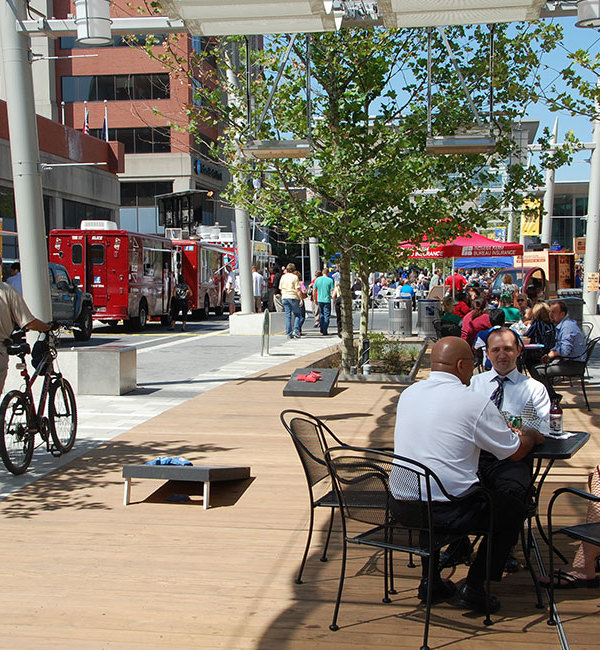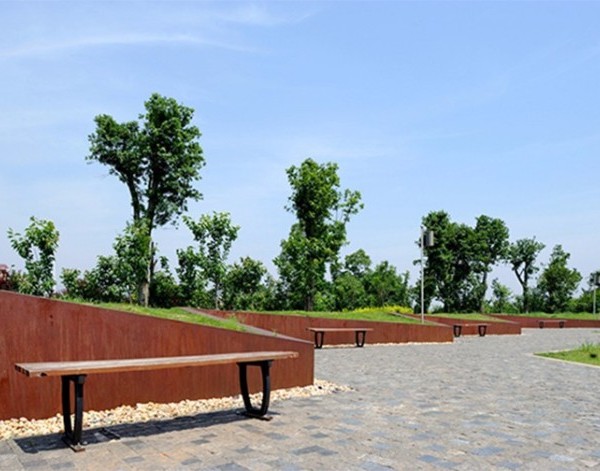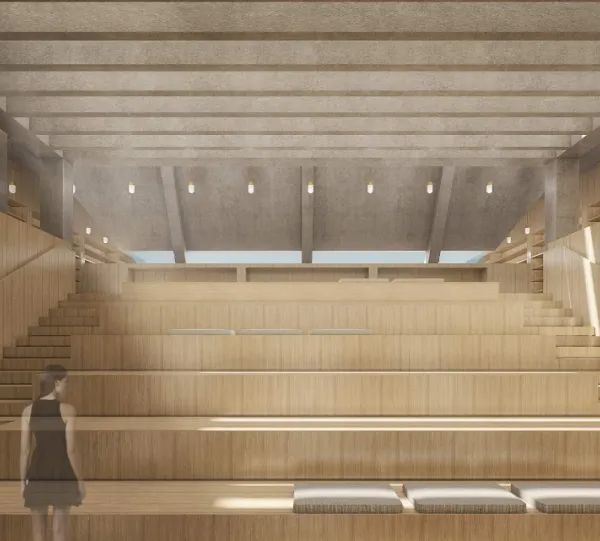西班牙 360º观景台 | 石砌景观与历史文化的完美融合
来自摄影师
Fotografía de Arquitectura
和WaterScales arquitectos
Appreciation towards the photographer
Fotografía de Arquitectura
场地与介入 | About the place and the intervention
WaterScales arquitectos for providing the following description:
Álora村庄坐落于Sierra del Hacho山脉的一个弓形地段,古老的Arrabal城镇环绕着山上的城堡。这个村庄有着丰富而有趣的历史,摩尔人曾在这里有过反抗天主教徒的斗争,弗拉门戈歌曲malagueña也在这里发源。该项目对城堡周围的建筑及环境进行了修复及重新改造,为的是在重塑公共设施的同时吸引更多的游客。建筑师提出了一个名为“tapestry scale 1:1”的方案,捕捉到了这片文化景观所蕴藏的能量。这个石制地图将带领游客探索、发现、了解并且体验这片文化景观。现方案第二阶段已经落地,它是通向城堡的必经之路,名为360º观景台。
场地鸟瞰,aerial view of the site ©Fernando Alda

360º观景台 | Viewpoint 360º
Cerro de las Torres(Towers’ hill)山上有一条通往城堡的小路,这条小路连接了城堡以及Arrabal城镇的主广场。在这条环路的主要转角处,即“拜苦路”(via crucis,耶稣身背十字架走向加尔瓦略山的路途)第八站的位置设有一个观景平台,可以俯瞰到Álora村庄的优美全景。
▼欣赏Álora村庄美丽全景的观测点,the viewpoint showing Álora’s landscape plenitude©Fernando Alda
The path toward the castle which surrounds the Cerro de las Torres (Towers’ hill) joins the Castle with the Plaza de la despedía (main square of the Arrabal). In its main curve, where the 8th via crucis stop is, appears the viewpoint showing Álora’s landscape plenitude.

▼弯曲的路径,the curving path©Fernando Alda
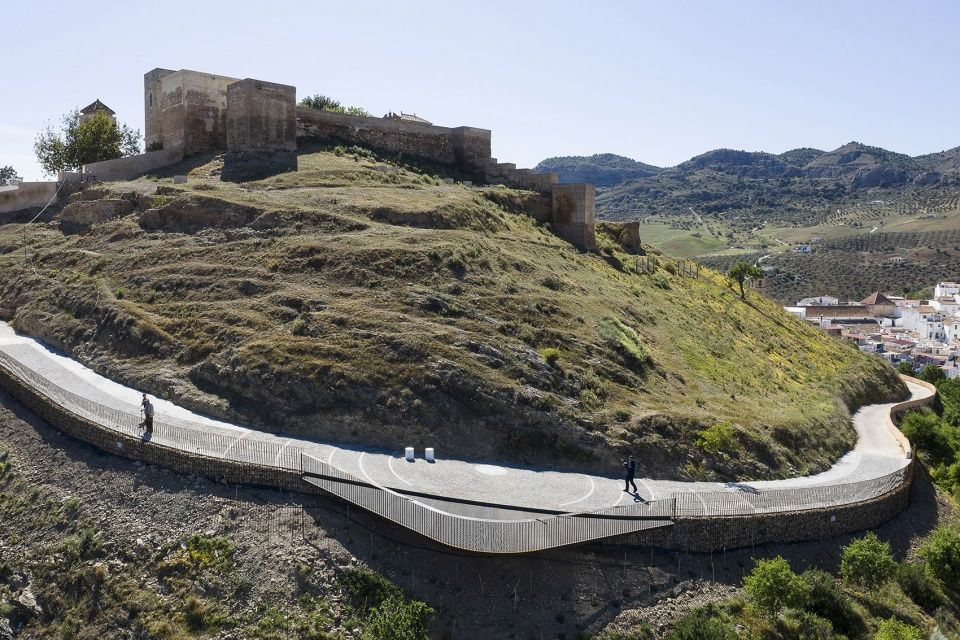
原先的道路并未得到很好的维护,朝向风景的一面墙壁被漆成了浅红棕色。在该项目中,新的游廊被打造为一条“石砌的地毯”。墙的设计旨在寻回一种“无形”的观感:下半部分由砂岩打造,与山体的色彩融为一体,上半部分则安装以空气般轻盈的栏杆。
The path was in a bad conservancy condition and the wall facing to the views painted in brown salmon colour. We have built the pavement as a stone carpet and the wall has been conceived looking for its “invisibility”. The lower part of the wall has been made in brown sandstone gabions with the colour of the hill. The upper part, the veranda is nearly an air vibration.
▼空气般无形存在的栏杆,the veranda as an air vibration©Fernando Alda

在靠近第八站的过程中,石砌路面的纹理变得愈加细腻,旁边的两个大理石座位提供了360º的观景视野。平台的内侧是美丽的自然景观:Guadalhorce的山谷、盆地和果树林;另一侧半挑出山腰,将当地重要的文化和自然景观尽收眼底,包括Jesús Nazareno de las Torres哥特式教堂、阿拉伯城堡、中世纪风格的村庄肌理以及高高耸立的Hacho山脉。
The stone path modifies its texture as it approaches to the 8th via crucis stop, two nearby marble seats and the viewpoint which suggests a dynamic 360º view. On one side, there is the natural landscape of valleys and the basin of the Guadalhorce with its orchards. On the other, thanks to our aerial position, we could link the main highlights of the cultural landscape: the Gothic chapel of Jesús Nazareno de las Torres, the Arab castle, and the medieval geometry of the village with the mount Hacho on its high.
▼两个大理石座位,two marble seats©Fernando Alda

可以看到Álora村庄全景的观景台,the viewpoint which suggests a dynamic 360º view©Fernando Alda

▼中世纪风格的村庄肌理以及高高耸立的Hacho山脉,the medieval geometry of the village with the mount Hacho on its high©Fernando Alda

材料与建造 | About materials and construction
材料的使用遵循它们自身的特性,材料的连接方式取决于项目的设计理念。
The materials are used following their own truth. Their way of joining follow our main project ideas.
材料连接细部,joining details of the materials©Fernando Alda
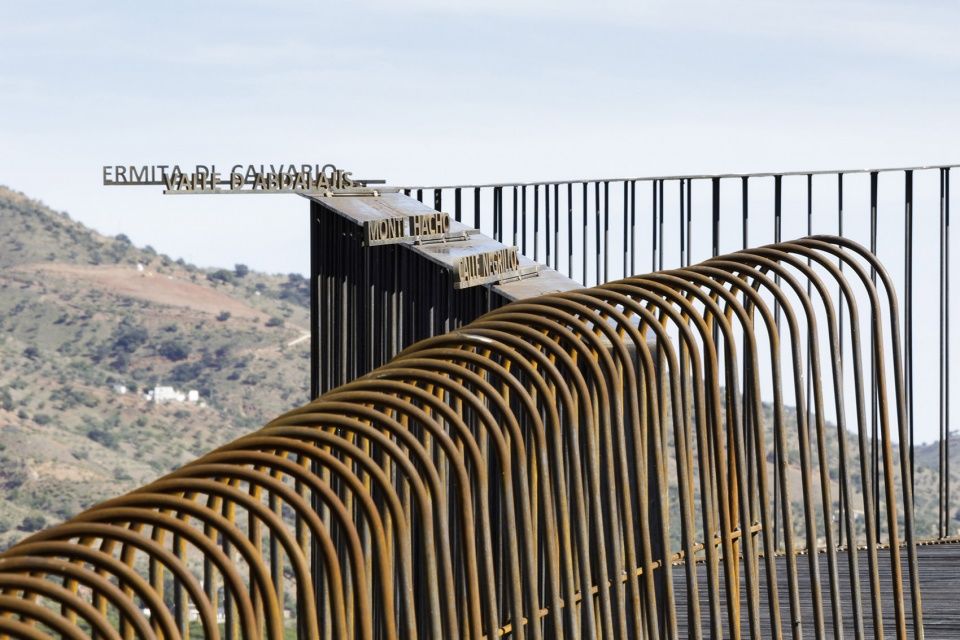
墙和栏杆 | Walland balustrade
游廊的边缘是由取自当地的砂岩填充而成的石笼构成。金属边线显现出氧化的颜色,与石材的颜色呼应。游廊上半部分的栏杆有一种通透感,形成了无形的的边界,人们可以从这里毫无阻碍地欣赏到远处的风景。
The edge of the path is made by gabions filled by sandstone from the surroundings. The metallic bars show their oxidation colour as well as stones do. The upper part of the balustrade, empty, makes a nearly invisible limit which alouds looking through the far landscape.
栏杆细部,balustrade details©Fernando Alda

铺地 | Floor
由于铺地花岗岩的石材尺寸、纹理和明暗度皆不相同,整条路的铺地也展现出其特有的韵律。最中间的“地毯”是由中等大小、较粗糙的深色方形石头铺成,而两侧的收边是由平坦的小铺路石拼接而成。地毯将观者引向一块有着涟漪状肌理的深色铺地,其中心指向一块圆形的大理石——这便是拜苦路的第八站。在不远处,两个圆柱形大理石座椅介入道路中间,模拟了圣经中两位耶路撒冷妇女在耶稣去往加略山的路途上安慰他的场景。
The vibrating floor is defined thanks to the different sizes, texture and darkness of the paving stones of granite. The central “carpet” is done by mid size squared, rough and dark stones. It is flanked by small and flat paving stones. The carpet leads to a dark pavement area geometrized in circle waves whose epicentre is a circled piece of marble which points out the 8th stop of the via crucis. Close to it, two cylindrical seats show their impact on pavement, simbolizing the biblical scene where two women from Jerusalem comforted Jesus on its way to the Calvary.
圆形波纹状区域,a pavement area geometrized in circle waves©Fernando Alda

▼铺地细部,the flooring details©Fernando Alda

▼拜苦路的第八处和两个圆柱形的座位,the 8th stop of the via crucis and thetwo cylindrical seats©Fernando Alda

观景台 | Viewpoint
观景台是通往城堡路上的一处冥想之地,同时也是文化景观的集结点。观景台的地面由金属板条构成,板条之间的缝隙使光线得以透过,形成独特的律动效果。细而直的栏杆支撑着较宽的金属扶手,扶手上的文字有的呈镂空雕刻状,有的则悬挑在空中。镂空雕刻的文字为旅行者讲述了当时的历史时期、重要人物和其他有趣的信息,而悬空的文字则指向各处景点的地理位置。
▼观景台,viewpoint©Fernando Alda
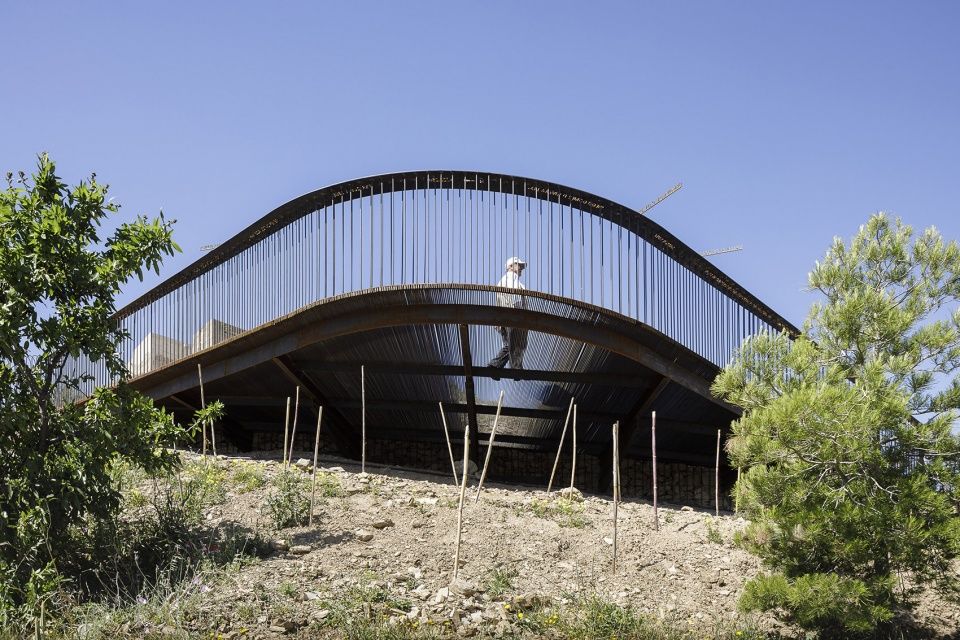
▼金属地板,floor made ofmetallic plates©Fernando Alda

▼观景台细栏杆,the balustrade made by thin vertical bars ©Fernando Alda
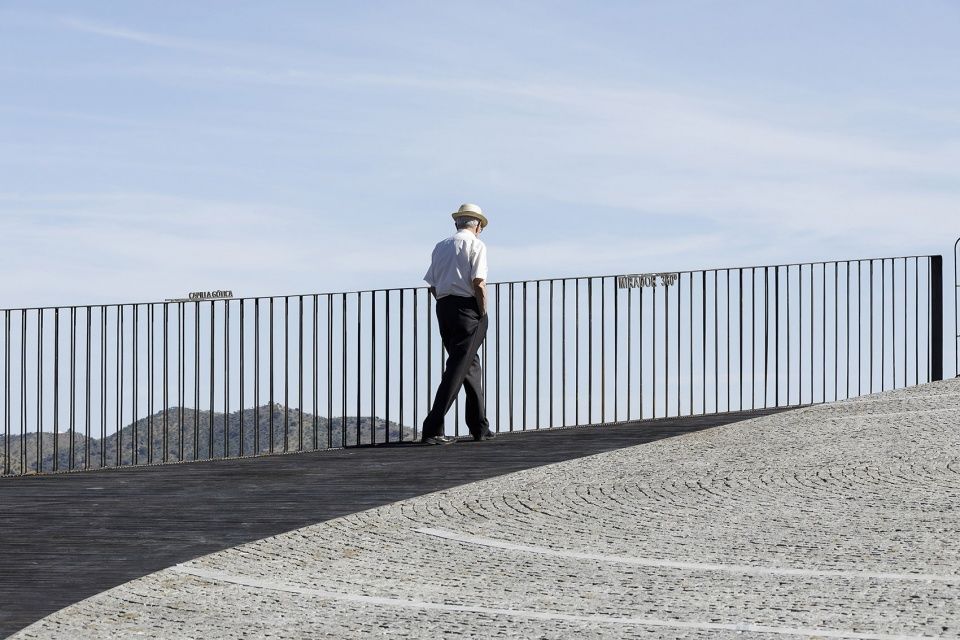
扶手上镂空雕刻的文字和悬挑的文字,handrail which contains perforated and aerial texts©Fernando Alda

园艺 | Gardening
设计师修复了山坡上的一部分荒地。修复的内容主要是在山坡的底端种植一些低维护成本的灌木、薰衣草和刺山柑。
We have recovered some abandoned areas of the slope. Our work has focused on the lower part of the slope where there have been planted low maintenance bush masses; lavender, lavandula, and caper, capparis spinosa.
灌木,bush masses©Fernando Alda
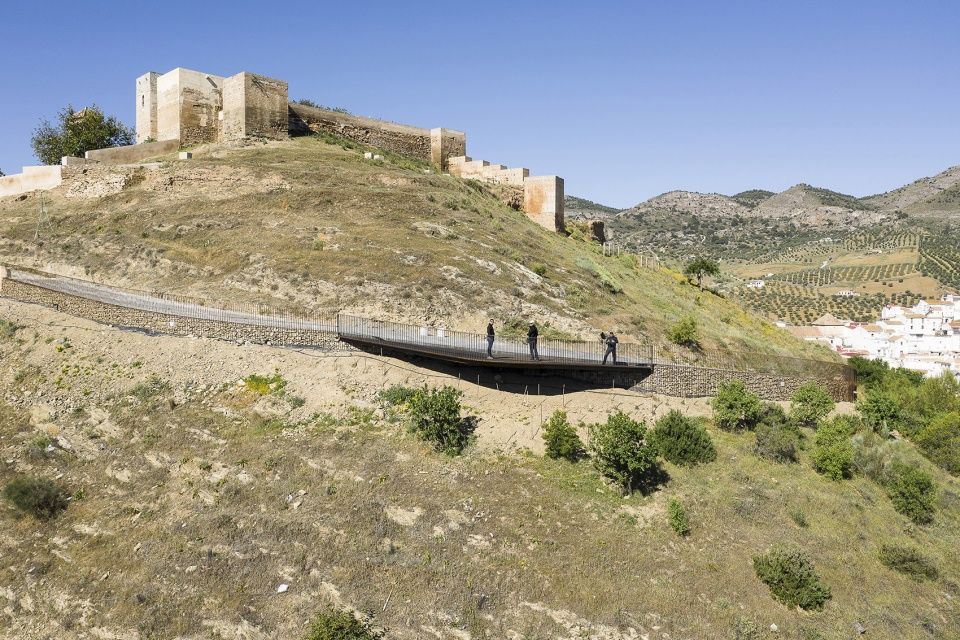
照明 | Lighting
日落时分,通往城堡的道路会亮起方形的嵌入式地灯,带来独特的韵律。在复活节期间,栏杆之间还会摆放节日蜡烛。
At sunset, the way to the castle is marked by a rhythm of small lighting square pavement, placed between the stone ones. During Easter acts, there will be candles inside the balustrade.
嵌入式地灯,small lighting square pavement©Fernando Alda

设计师希望可以捕捉到这片场地的精髓,向游客提供一种感受Álora村庄历史和风景的全新方式。游廊和 360º观景台的存在则使得景观的价值和意义得到了充分的展现。
We would have liked having captured the essence of landscape and having shown to the traveller a new way of feeling the historical landscape of Álora. The path and the viewpoint underline the landscape making its values emerge.
▼手绘草图,design sketches

▼场地平面图,site plan
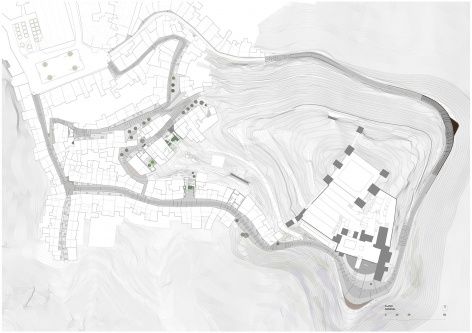
▼平面图,plan
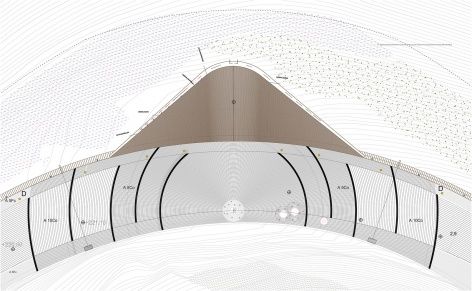
▼园艺平面图,gardening plan
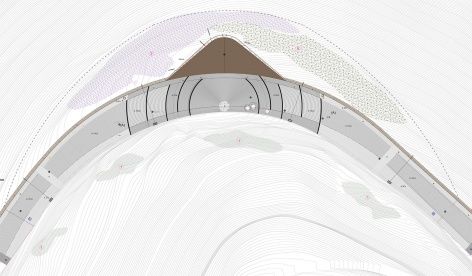
▼剖面图,section
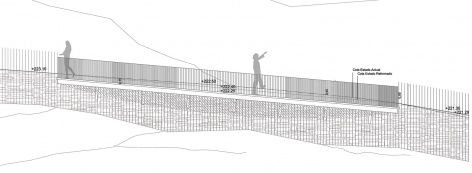
▼节点图,construction details
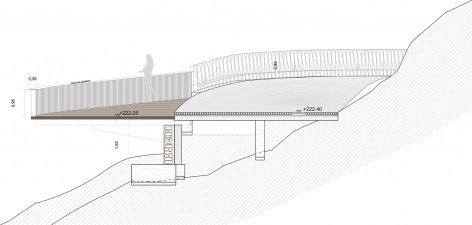
Location: Cerro de la Torres, Álora, Málaga, Spain
Architects: WaterScales arquitectos (Carmen Barrós Velázquez & Francisco J. del Corral del Campo)Technical Surveyor: Antonio Montes Sáez
Garden and landscape: Ana Ibáñez Fernández, Biólogist
Structures: Jesús Hernández Martí, Civil Engineer
Installations: Ingeniería Vargas. Esteban Vargas y José Manuel Fernández, Industrial Engineer
Ricardo Rueda García, Civil Engineer
Assistants:Javier Golbano Gómiz, architect
Álvaro López Camino, architect
Jorge López González, architect
Daniel Marcos Ruiz, architect
Belén Muñoz de la Torre Calzado, architect
Francisco Ortega Ruiz, architect
Felipe Pérez García, architect
Patricia Prados Pérez, architect
Víctor Campoy Martín, architect
Builder: I.M. Instalaciones y Obras S.A. (Álora)Developer: Excmo. Ayuntamiento de Álora
Historical assistance: María José Sánchez Rodríguez, Director Archaelogical museum, Álora
Archaeology: Taller de investigaciones arqueológicas, Málaga
Photograhs: Fernando Alda


